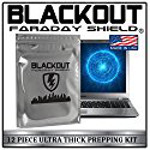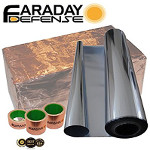hofmeister research - information and knowledge base
There are many ways an Electromagnetic Pulse (EMP) could be generated. We will focus on the main two that have detrimental effects on electrical equipment and electronics. A Coronal Mass Ejection (CME) and a High Power Electromagnetic Pulse (HEMP). These two represent the most likely source of any threat.
Jump directly to EMP Protection Solutions.
About HPEM - High Power Electromagnetism
Primary Causes of HPEM pulses:
Coronal Mass Ejection Directed at Earth High Altitude Nuclear Detonation


Electromagnetism
Electromagnetism is the relationship and interaction of electricity and magnetism. While electricity is well understood, magnetism has eluded even the most brilliant and learned of scholars. With his theory of special relativity, Albert Einstein established that both electricity and magnetism are aspects of one common phenomenon. Some examples of electromagnetism we interact with and affects us every day are, visible light, cell phone calls, wifi, microwave cooking, radio, x-rays, getting a sun tan/burn, and the list goes on and on ...

Electromagnetism has some very strange properties. Let's take a look at the electromagnetic spectrum and something we are all familiar with, visible light. The properties of light can be observed both as a particle in certain situations and as a wave in others. We will focus on the wave property as the frequency and amplitude/strength of the wave pulse is what can directly effect us.
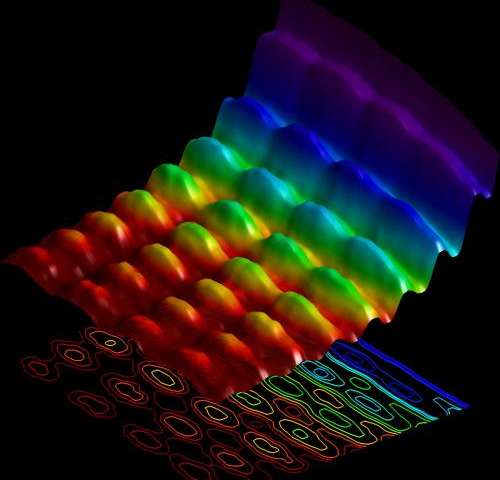
We're all familiar with ocean waves at the beach. As each wave takes time to hit the shore line, this time measurement is the frequency. With the frequency, and the distance from wave to wave, we can determine the speed of the waves as well. The height of the wave is the amplitude or strength. We need to pay attention to this attribute as well. Everything gets bombarded by electromagnetic waves constantly, but the amplitude is so low that there are few if any adverse effects. On the other hand, a very strong pulse at the right frequency can be extremely detrimental.
To put frequency in perspective, visible light is measured in nanometers. Red has the longer waves centered around 700nm. Green centers around 530nm with violet around 420nm. A nano meter is one billionth of a meter (0.000 000 001 m or 1 x 10-9m). That's pretty small. On the other hand, radio waves like you hear in your car can be miles long.
Heads up, electromagnetic waves travel at the speed of light. This sits around 186,282 miles per second (~ 3.00 x 108m/s). The fastest speed known to man and according to Mr. Einstein, a limit that cannot be surpassed.
- Further reading at Britannica can be found here.
- Study Electromagnetism at MIT OpenCourseware here.
Electromagnetic Pulse (EMP)
Who was Richard Carrington? In 1859, a Coronal Mass Ejection (CME) hit earth's magnetosphere and induced one of the largest geomagnetic storms on record. Auroras where seen as far south as the carribean. Telegraph systems all over North America and Europe failed, delivering electrical shocks to some operators and igniting fires.
Richard Carrington actually observed the solar flare (White Light Flare - CME) prior to this event. He put two and two together and deduced the association between the CME and the electrical disruption, and a CME of this magnitude is now called a Carrington Event. The Solar Storm of 2012 was of similar magnitude but the brunt of the ejection missed the earth. Studies show that if we experience a Carrington Event, our problem would be magnified substantially because of societies' reliance on technology.
- Further reading at Wikipedia can be found here.
What is an EMP? An Electromagnetic Pulse, as the name suggests, is an energy fluctuation. If the electrmagnetic fluctuation, ie. pulse, has enough energy and is at a high frequency, the pulse will induce a high voltage/current spike on any exposed conductive surface, including the tiniest circuitry in todays electronic devices. Anything that is not shielded will experience this spike and more than likely fail. Richard Carrington observed the "first" EMP and was able to correlate this event with the destruction of telegraph equipment and the like. Multiple tests were conducted by various governments to verify and measure this effect using nuclear explosions.
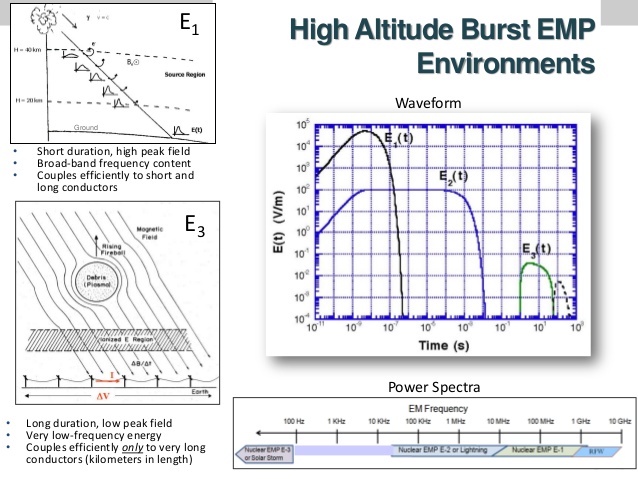
A destructive EMP is defined by the IEC as three primary spikes labelled E1, E2 and E3. The blast from a nuclear detonation initially produces the extremely destructive E1 pulse.
- Further reading can be found here.
What is the threat?
From what we've learned so far, a major threat could come from two main sources. Our sun could experience a Coronal Mass Ejection (CME) directed at the earth, or, through weapons of mass destruction, ie. a nuclear warhead detonated at a sufficient height, generating a High Altitude Electromagnetic Pulse (HEMP). A third and fairly unknown potential threat is Intentional Electromagnetic Interference (IEMI).
Threat from a Coronal Mass Ejection (CME) Geomagnetic storms are a fairly common occurance seen in the aurora lights. They can be predicted to a certain degree, just like the weather following the suns regular solar cycle of sun spots.
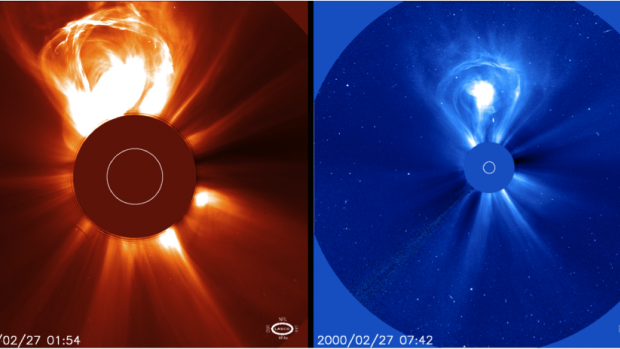
We are familiar with the CME event of 1859 through the observations of Richard Carrington. These events are not rare and in 2012, the earth experienced a "near miss". A powerful coronal mass ejection ripped through earth orbit on July 23, 2012 and fortunately, the earth was not there. Instead, the storm cloud hit the STEREO-A spacecraft. In 2014, Daniel Baker of the University of Colorado said, "If it had hit, we would still be picking up the pieces". Baker continues, "I have come away from our recent studies more convinced than ever that Earth and its inhabitants were incredibly fortunate that the 2012 eruption happened when it did. If the eruption had occurred only one week earlier, Earth would have been in the line of fire."
- Further reading about CME's at NOAA can be found here.
- Further reading from National Geographic can be found here.
- Further reading about "Space Weather" and their effects at NOAA can be found here.
Threat from a High Altitude Electromagnetic Pulse (HEMP) With the advent of atomic weapons, it was found that when detonated, an EMP is generated. Scientists observed that during the initial conflagration, when detonated close to the ground the pulse is absorbed. But a High Altitude Electromagnetic Pulse (HEMP) is generated when detonated above 30 km. These EMP's can propogate over great distances thus affecting and sending a detrimental pulse through anything conductive that it encounters.
In 1962, a high-altitude nuclear test was conducted by the United States called Starfish Prime. A fairly small nuclear warhead by todays standards, approx. 1.4 megatons, was successfully detonated at an altitude of 240 miles. The actual EMP was far more powerful than expected and much of the instrumentation was inadequate in getting valid measurements. There were quite a few unexpected public observations 900 miles away in Hawaii. Artificial auroras lit up the night sky over hugh swaths of the Pacific Ocean, over 300 streetlights knocked out, burglar alarms triggered, tripped power-line circuit breakers, a microwave link was damaged disrupting telephone communications between the islands, not to mention the half dozen or so satellites that were compromised and eventually failed as a direct result.
- Further reading on Starfish Prime can be found here.
- Further reading from the EMP Commission can be found here.
Other IEMI's - High Power Microwaves (HPM) Although the CME and HEMP can cover a very large area and potentially an entire continent, the High Power Microwave (HPM) threat is a concept that is non-explosive and very localized and directional. The threat is much lower in that it doesn't affect a large area, but the potential for damage is much greater in densely populated areas. Governments have been working on this for many years with limited success as far as public information is concerned.
- Further reading from Scientific American can be found here.
EMP Protection - Introducing Michael Faraday

Michael Faraday - The Father of Electronics. Through a series of experiments, in 1831 Michael Faraday discovered electromagnetic induction. He demonstrated that a changing magnetic field produces an electric field.
- Further reading from FamousScientists.org can be found here.
What is a Faraday Cage? In 1836, Michael Faraday discovered that electrical charge only resides on the exterior of a charged conductor, and an exterior charge has no influence on anything enclosed within a conductor. With an enclosure, the exterior charges redistribute such that the interior field due to them cancel (the Faraday cage principle).
The Faraday principle is what's used for shielding electromagnetic radiation. The Faraday cage can be used to prevent the passage of electromagnetic waves and electric fields, either containing them in or excluding them from its interior space. A Faraday cage will effectively shield the interior from electromagnetic radiation if the conductor walls are thick enough and any holes are significantly smaller than the radiations wavelength. How much protection is determined by the strength of the EMP and how much electromagnetic radiation the shielding can attenuate.
- Further reading from the National High Magnetic Field Laboratory can be found here.
- Further technical reading from Oxford University can be found here.
Mil-Specs
Obviously the military would take the threat of an EMP seriously and conduct the most research and testing. From this, specifications have been determined for the most effective shielding. This is certainly not a comprehensive list:
MIL-STD-461 DEPARTMENT OF DEFENSE INTERFACE STANDARD: REQUIREMENTS FOR THE CONTROL OF ELECTROMAGNETIC INTERFERENCE CHARACTERISTICS OF SUBSYSTEMS AND EQUIPMENT
- Specification can be found here.
MIL-STD-464 DEPARTMENT OF DEFENSE INTERFACE STANDARD: ELECTROMAGNETIC ENVIRONMENTAL EFFECTS, REQUIREMENTS FOR SYSTEMS
- Specification can be found here.
MIL-STD-188-125 MILITARY STANDARD SHEET: HIGH-ALTITUDE ELECTROMAGNETIC PULSE (HEMP) PROTECTION FOR GROUND-BASED C4I FACILITIES PERFORMING CRITICAL, TIME-URGENT MISSIONS
- Specification can be found here.
MIL-PRF-131 PERFORMANCE SPECIFICATION: BARRIER MATERIALS, WATER VAPORPROOF, GREASEPROOF, FLEXIBLE, HEAT-SEALABLE
- Specification can be found here.
HofResearch EMP Protection Solutions
ATTENTION! - Before you go down this road, please keep in mind that if all the pieces of the "puzzle" aren't protected, anything you do have protected is useless. A cell phone will not work without cell towers. Getting online won't work without a wifi or direct connection, provided the internet is even still up and running. Nothing works after your batteries are dead if you have no power to charge them with. And the list goes on ...
With that in mind, lets look at some considerations:
- You have to shield everything you're trying to protect.
- any electronics not shielded is suseptible to damage - Shielding has to completely surround the contents.
- like a box/cage - The shielding cannot have any gaps in it.
- the box cannot have spaces where the electro-magnetic waves can leak through - The contents being protected have to be electrically isolated from the shielding.
- insulation is needed between the shielding and the devices - Multiple layers of shielding may be required.
- if your shielding is not thick steel, multiple layers may be necessary - There is no way to actually test whether your shielding is adaquate in a catastrophic situation.
- short of an actual catastrophy
How to protect electronics from an EMP:
At a minimum, the simplest and probably (see #6 above) functional method is to get a metal container with no straight through gaps, insulate on the inside so your electronics are isolated, and put your devices in it. An example would be an all metal cookie box or full-sized metal trash can, lined with cardboard or some other non-conducting material, and then tape the entire seam of the lid with conductive tape to make sure there are no gaps. Check and make sure there is no other potential gaps at any other seams or along the bottom.
For more insurance, layering will increase protection incrementally. A metal box within a metal box, faraday bag within a metal box, bag within bag within box, bag within bag within bag, etc. Don't forget insulating each of the layers from each other or they will do no good.
Using these principles, adequate protection can be fabricated with just about any type of enclosure by shielding. A fully functional DIY faraday cage is well within the realm of possibilities. You could make a simple faraday cage with a shoe box by completely covering the outside with aluminum foil. Anything inside would be isolated by the cardboard and the aluminum foil would provide the shielding. I would use extra heavy duty foil for the added protection. Another layer of protection can be added by putting your devices inside a faraday bag. An entire building could be made out of metal or covered with shielding, provided all the gaps are taken care of. Again, keep in mind the basic tenets above, gaps, layering, etc.
Back to the initial WARNING, all the pieces of the "puzzle" need to be protected!
Final Thoughts ...
The most suseptible thing to a powerful EMP is the power grid because of the long transmission power lines criss-crossing across our entire country. These long lines will act as antennae and the destructive pulse wave will travel along them. Electricity affects virtually every aspect of our lives and the result would be a complete breakdown of society. And if the power grid goes down, it could be a long time before distributed power is restored. Without a power source, there's no way to get clean water out of the ground because water pumps need electricity, no gas pumps or atm machines, no communications equipment, radio, TV, no life-saving medical devices or food production equipment, ... we rely completely on electricity.
Figure out what electrical/electronic devices you would need to protect for survival in the event of an EMP catastrophy, (ie. necessary life-saving medical devices, communications equipment, etc.) and put together a comprehensive shielded package with all the components necessary to attain your goal.
Jump to EMP Protection Products.

